Physics-Embedded Deep Learning to Predict Real-Time Flow Parameters in Complex Thermodynamic Machinery
Abstract
1. Introduction
2. Complex Flow in the Propulsion of Aircraft
3. Physics-Embedded Deep Learning for Investigating Complex Flow in Turbofan Engines
4. Component Networks
5. Results
5.1. Real-Time Prediction of the Exhaust Gas Temperature
5.2. Real-Time Prediction of the Total Pressure
5.3. Real-Time Performance Degradation Comparison
6. Conclusions
Author Contributions
Funding
Data Availability Statement
Acknowledgments
Conflicts of Interest
References
- Yarom, E.; Sharon, E. Experimental observation of steady inertial wave turbulence in deep rotating flows. Nat. Phys. 2014, 10, 510. [Google Scholar] [CrossRef]
- Barkley, D.; Song, B.; Mukund, V.; Lemoult, G.M.; Hof, A.B. The rise of fully turbulent flow. Nature 2015, 526, 550. [Google Scholar] [CrossRef]
- Bauer, P.; Thorpe, A.; Brunet, G. The quiet revolution of numerical weather prediction. Nature 2015, 525, 47–55. [Google Scholar] [CrossRef]
- Falkovich, G.; Sreenivasan, K.R. Lessons from hydrodynamic turbulence. Phys. Today 2006, 59, 43–49. [Google Scholar] [CrossRef]
- Ozawa, H.; Shimokawa, S.; Sakuma, H. Thermodynamics of fluid turbulence: A unified approach to the maximum transport properties. Phys. Rev. E 2001, 64, 026303. [Google Scholar] [CrossRef]
- Righi, M.; Pachidis, V.; Konozsy, L.; Giersch, T.; Schrape, S. Experimental validation of a three-dimensional through-flow model for high-speed compressor surge. Aerosp. Sci. Technol. 2022, 128, 107775. [Google Scholar] [CrossRef]
- LeCun, Y.; Bengio, Y.; Hinton, G. Deep learning. Nature 2015, 521, 436–444. [Google Scholar] [CrossRef]
- Sarker, I.H. Deep learning: A comprehensive overview on techniques, taxonomy, applications and research directions. SN Comput. Sci. 2021, 2, 420. [Google Scholar] [CrossRef] [PubMed]
- Schmidhuber, J. Deep learning in neural networks: An overview. Neural Netw. 2015, 61, 85–117. [Google Scholar] [CrossRef] [PubMed]
- Senior, A.W.; Evans, R.; Jumper, J.; Kirkpatrick, J.; Sifre, L.; Green, T.; Qin, C.; Žídek, A.; Nelson, A.W.R.; Bridgland, A.; et al. Improved protein structure prediction using potentials from deep learning. Nature 2020, 577, 706–710. [Google Scholar] [CrossRef] [PubMed]
- Devlin, J.; Chang, M.W.; Lee, K.; Toutanova, K. Bert: Pre-training of deep bidirectional transformers for language understanding. arXiv 2018, arXiv:1810.04805. [Google Scholar]
- Rajkomar, A.; Oren, E.; Chen, K.; Dai, A.M.; Hajaj, N.; Hardt, M.; Liu, P.J.; Liu, X.; Marcus, J.; Sun, M.; et al. Scalable and accurate deep learning with electronic health records. NPJ Digit. Med. 2018, 1, 18. [Google Scholar] [CrossRef] [PubMed]
- Chen, Y.; Wang, S.; Liu, W. Data-Driven Transition Models for Aeronautical Flows with a High-Order Numerical Method. Aerospace 2022, 9, 578. [Google Scholar] [CrossRef]
- Xie, C.; Wang, J.; Li, K.; Ma, C. Artificial neural network approach to large-eddy simulation of compressible isotropic turbulence. Phys. Rev. E 2019, 99, 053113. [Google Scholar] [CrossRef] [PubMed]
- Dong, Y.; Liao, F.; Pang, T.; Su, H.; Zhu, J.; Hu, X.; Li, J. Boosting adversarial attacks with momentum. In Proceedings of the IEEE Conference on Computer Vision and Pattern Recognition 2018, Salt Lake City, UT, USA, 18–21 June 2018. [Google Scholar]
- Rauker, T.; Ho, A.; Casper, S.; Hadfield-Menell, D. Toward transparent ai: A survey on interpreting the inner structures of deep neural networks. In Proceedings of the 2023 IEEE Conference on Secure and Trustworthy Machine Learning (SaTML), San Francisco, CA, USA, 8–10 February 2023. [Google Scholar]
- Xu, F.; Uszkoreit, H.; Du, Y.; Fan, W.; Zhao, D.; Zhu, J. Explainable ai: A brief survey on history, research areas, approaches and challenges. In Proceedings of the Natural Language Processing and Chinese Computing: 8th CCF International Conference, NLPCC 2019, Dunhuang, China, 9–14 October 2019. [Google Scholar]
- Haakon, R.; Suraj, P.; Adil, R.; Omer, S. Physics guided neural networks for modelling of non-linear dynamics. Neural Netw. 2022, 154, 333–345. [Google Scholar]
- Amos, B.; Kolter, J.Z. OptNet: Differentiable optimization as a layer in neural networks. arXiv 2021, arXiv:1703.00443. [Google Scholar]
- Pang, G.; D’Elia, M.; Parks, M.; Karniadakis, G.E. nPINNs: Nonlocal physics-informed neural networks for a parametrized nonlocal universal Laplacian operator. Algorithms and applications. J. Comput. Phys. 2020, 422, 109760. [Google Scholar] [CrossRef]
- Zanardi, I.; Venturi, S.; Panesi, M. Adaptive physics-informed neural operator for coarse-grained non-equilibrium flows. Sci. Rep. 2023, 13, 15497. [Google Scholar] [CrossRef]
- Xu, C.; Yongjie, F.; Shuo, L.; Xuan, D. Physics-Informed Neural Operator for Coupled Forward-Backward Partial Differential Equations. In Proceedings of the 1st Workshop on the Synergy of Scientific and Machine Learning Modeling ICML2023, Honolulu, HI, USA, 28 July 2023. [Google Scholar]
- Zobeiry, N.; Humfeld, K.D. A physics-informed machine learning approach for solving heat transfer equation in advanced manufacturing and engineering applications. Eng. Appl. Artif. Intell. 2021, 101, 104232. [Google Scholar] [CrossRef]
- Arnold, F.; King, R. State-space modeling for control based on physics-informed neural networks. Eng. Appl. Artif. Intell. 2021, 101, 104195. [Google Scholar] [CrossRef]
- Shinjan, G.; Amit, C.; Georgia, O.B.; Biswadip, D. RANS-PINN based Simulation Surrogates for Predicting Turbulent Flows. In Proceedings of the 1st Workshop on the Synergy of Scientific and Machine Learning Modeling ICML2023, Honolulu, HI, USA, 28 July 2023. [Google Scholar]
- Balli, O.; Caliskan, H. Turbofan engine performances from aviation, thermodynamic and environmental perspectives. Energy 2021, 232, 121031. [Google Scholar] [CrossRef]
- Tsoutsanis, E.; Li, Y.G.; Pilidis, P.; Newby, M. Part-load performance of gas turbines: Part I—A novel compressor map generation approach suitable for adaptive simulation. In Proceedings of the ASME Gas Turbine India Conference 2012, Mumbai, India, 1–3 December 2012. [Google Scholar]
- Tsoutsanis, E.; Li, Y.G.; Pilidis, P.; Newby, M. Part-load performance of gas turbines: Part II-Multi-point adaptation with compressor map generation and ga optimization. In Proceedings of the ASME Gas Turbine India Conference 2012, Mumbai, India, 1–3 December 2012. [Google Scholar]
- Liu, J.; Zhang, Q.; Pei, J.; Tong, H.; Feng, X.; Wu, F. Fsde: Efficient evolutionary optimization for many-objective aero-engine calibration. Complex Intell. Syst. 2022, 8, 2731–2747. [Google Scholar] [CrossRef]
- Flack, R.D. Fundamentals of Jet Propulsion with Applications; Cambridge University Press: Cambridge, UK, 2005; Volume 17. [Google Scholar]
- Pinto, R.N.; Afzal, A.; D’Souza, L.V.; Ansari, Z.; Mohammed Samee, A. Computational fluid dynamics in turbomachinery: A review of state of the art. Arch. Comput. Methods Eng. 2017, 24, 467–479. [Google Scholar] [CrossRef]
- Goodfellow, I.; Bengio, Y.; Courville, A. Deep Learning; MIT Press: Cambridge, MA, USA, 2016. [Google Scholar]
- Nagarajan, V. Explaining generalization in deep learning: Progress and fundamental limits. arXiv 2021, arXiv:2110.08922. [Google Scholar]
- Karniadakis, G.E.; Kevrekidis, I.G.; Lu, L.; Perdikaris, P.; Wang, S.; Yang, L. Physics-informed machine learning. Nat. Rev. Phys. 2021, 3, 422–440. [Google Scholar] [CrossRef]
- Elattar, H.M.; Elminir, H.K.; Riad, A.M. Towards online data-driven prognostics system. Complex Intell. Syst. 2018, 4, 271–282. [Google Scholar] [CrossRef]
- Tartakovsky, A.M.; Marrero, C.O.; Perdikaris, P.; Tartakovsky, G.D.; Barajas-Solano, D. Physics-informed deep neural networks for learning parameters and constitutive relationships in subsurface flow problems. Water Resour. Res. 2020, 56, e2019WR026731. [Google Scholar] [CrossRef]
- Yang, L.; Zhang, D.; Karniadakis, G.E. Physics-informed generative adversarial networks for stochastic differential equations. SIAM J. Sci. Comput. 2020, 42, 292–317. [Google Scholar] [CrossRef]
- Raissi, M.; Perdikaris, P.; Karniadakis, G.E. Physics-informed neural networks: A deep learning framework for solving forward and inverse problems involving nonlinear partial differential equations. J. Comput. Phys. 2019, 378, 686–707. [Google Scholar] [CrossRef]
- Han, J.; Jentzen, A.; Weinan, E. Solving high-dimensional partial differential equations using deep learning. Proc. Natl. Acad. Sci. USA 2018, 115, 8505–8510. [Google Scholar] [CrossRef]
- Han, J.; Jentzen, A.; Ee, W. Deep learning-based numerical methods for high-dimensional parabolic partial differential equations and backward stochastic differential equations. Commun. Math. Stat. 2017, 5, 349–380. [Google Scholar]
- Sirignano, J.; Spiliopoulos, K. DGM: A deep learning algorithm for solving partial differential equations. J. Comput. Phys. 2018, 375, 1339–1364. [Google Scholar] [CrossRef]
- Wigstrom, H. A neuron model with learning capability and its relation to mechanisms of association. Kybernetik 1973, 12, 204–215. [Google Scholar] [CrossRef] [PubMed]
- Gers, F.A.; Schmidhuber, J.; Cummins, F. Learning to forget: Continual prediction with lstm. Neural Comput. 2000, 12, 2451–2471. [Google Scholar] [CrossRef]
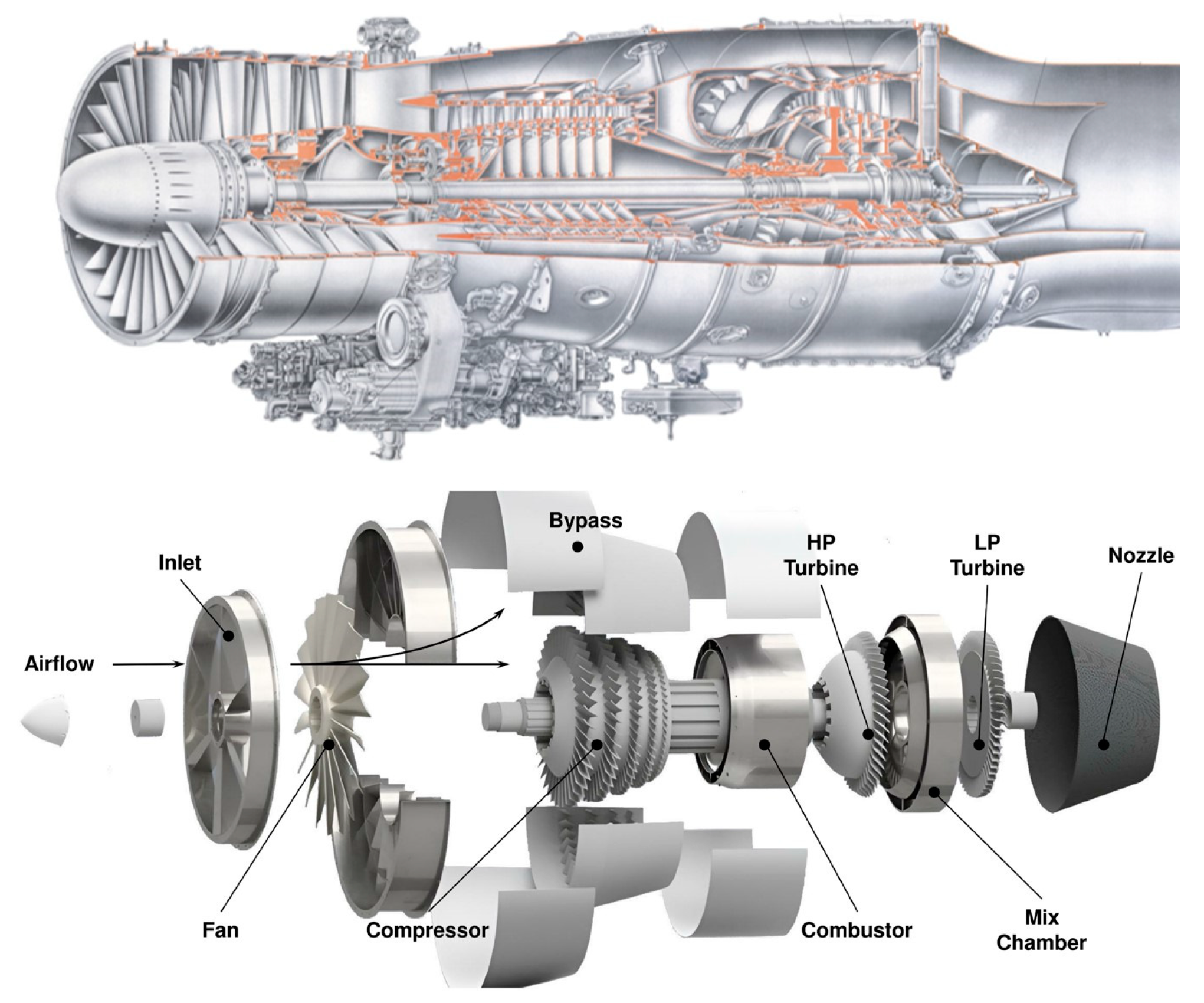
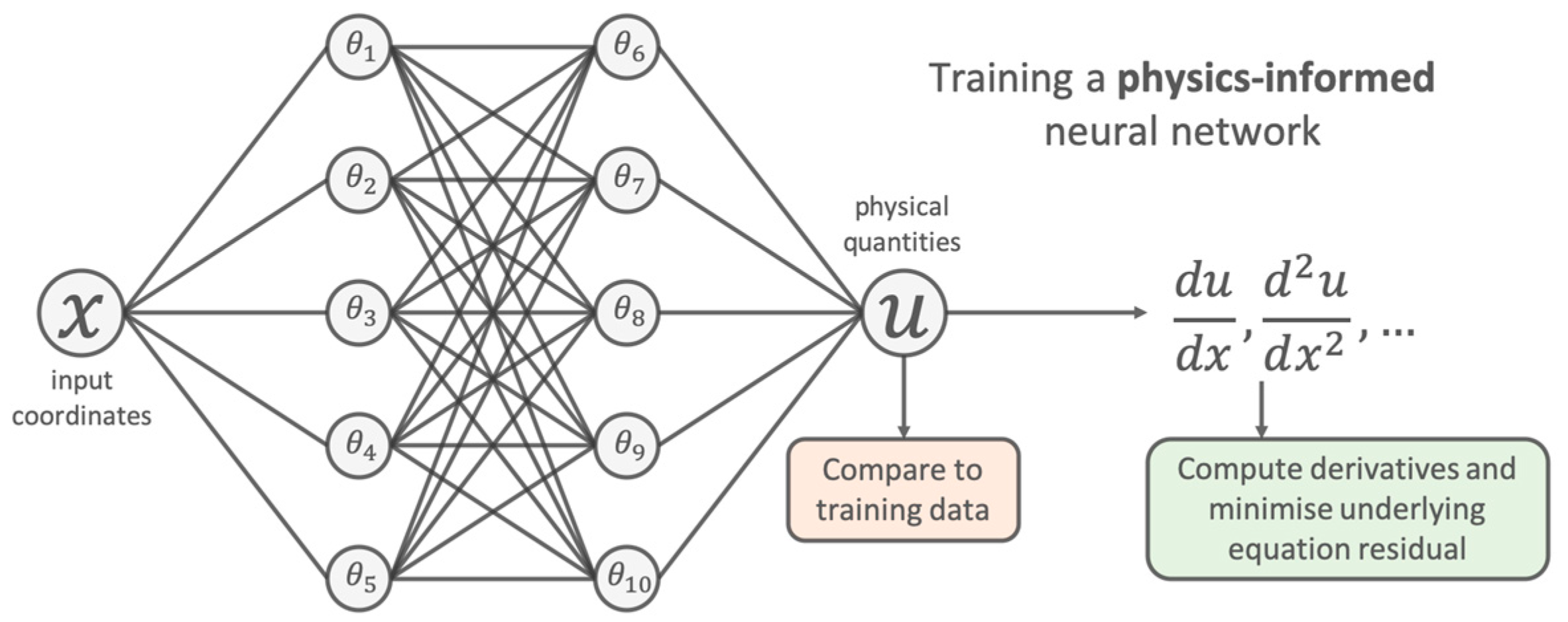
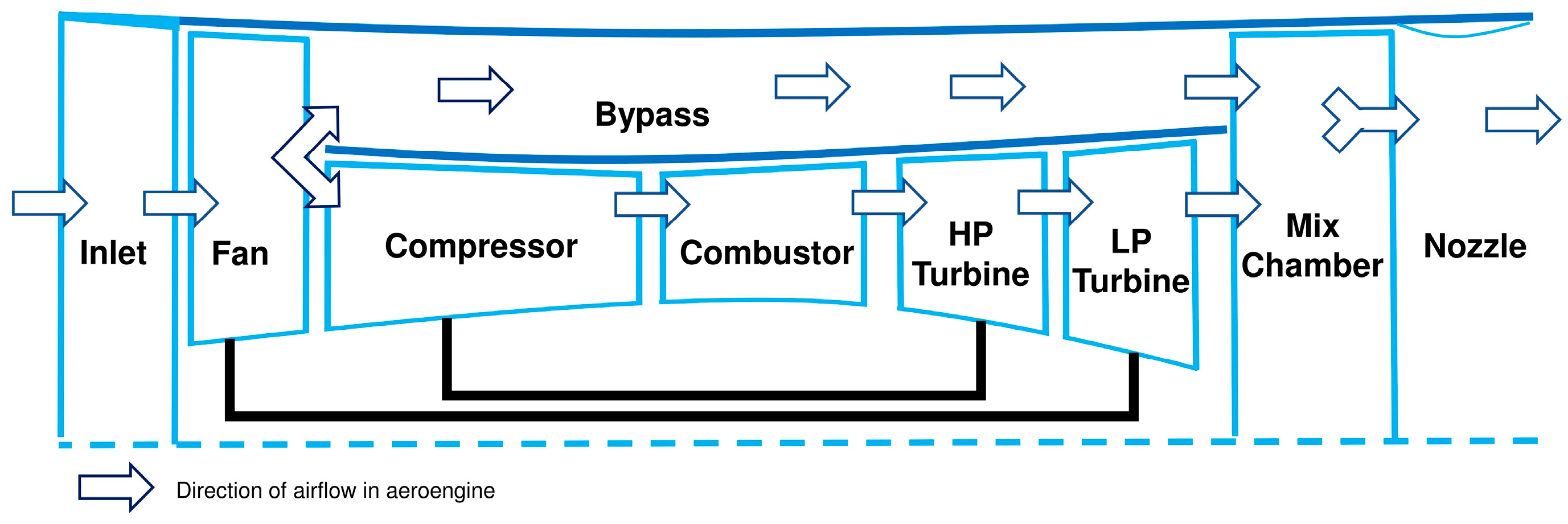







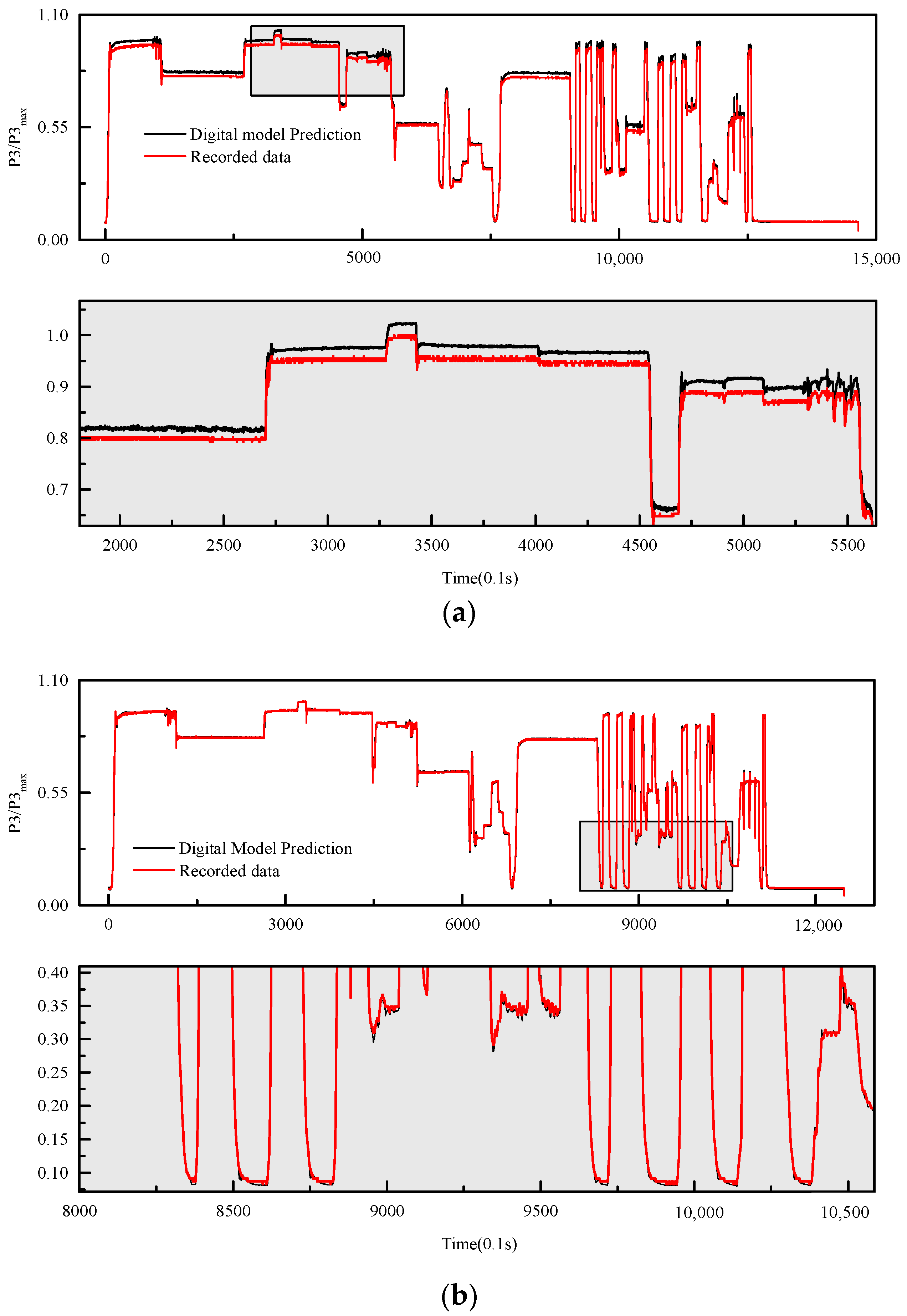



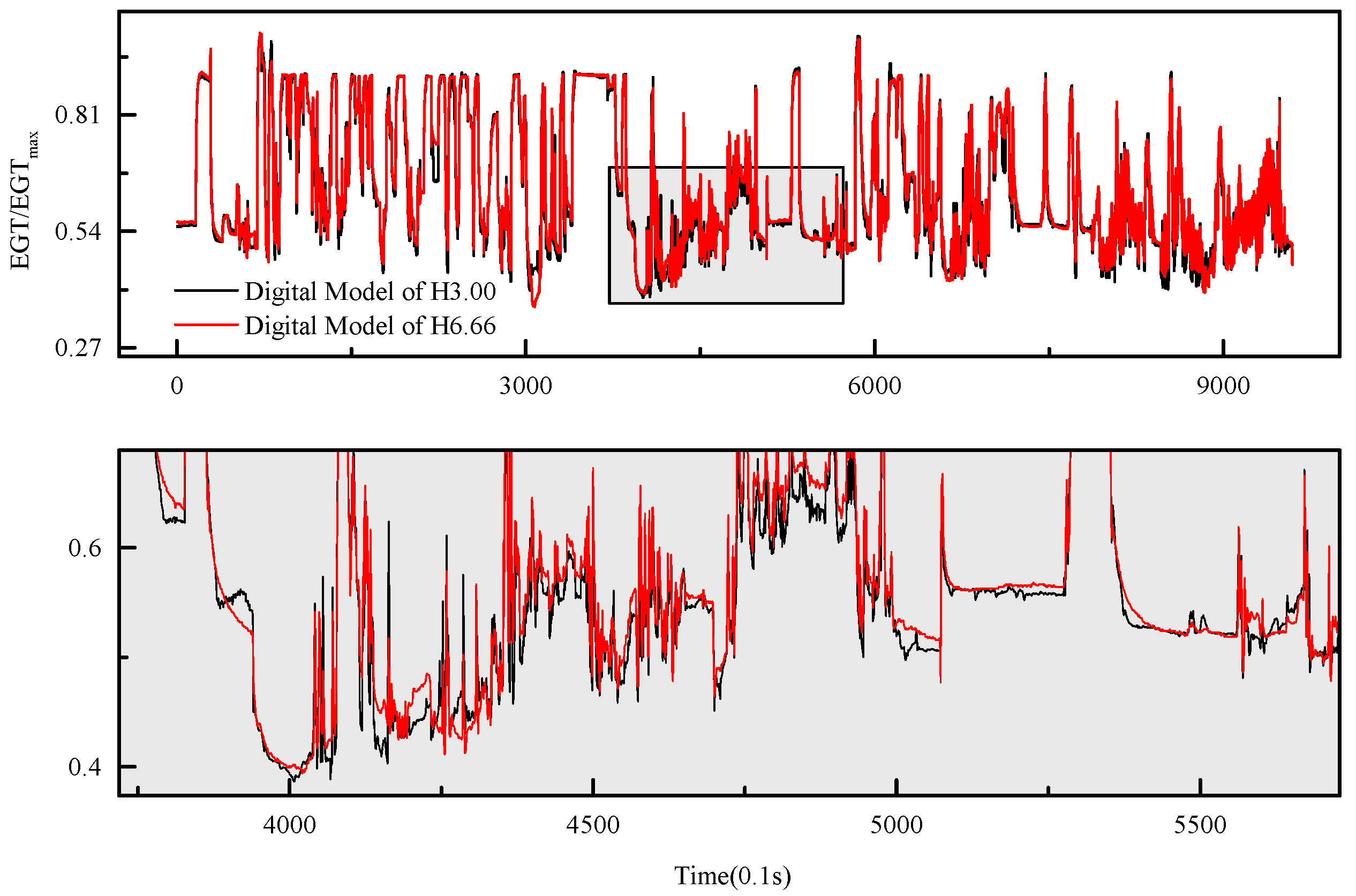


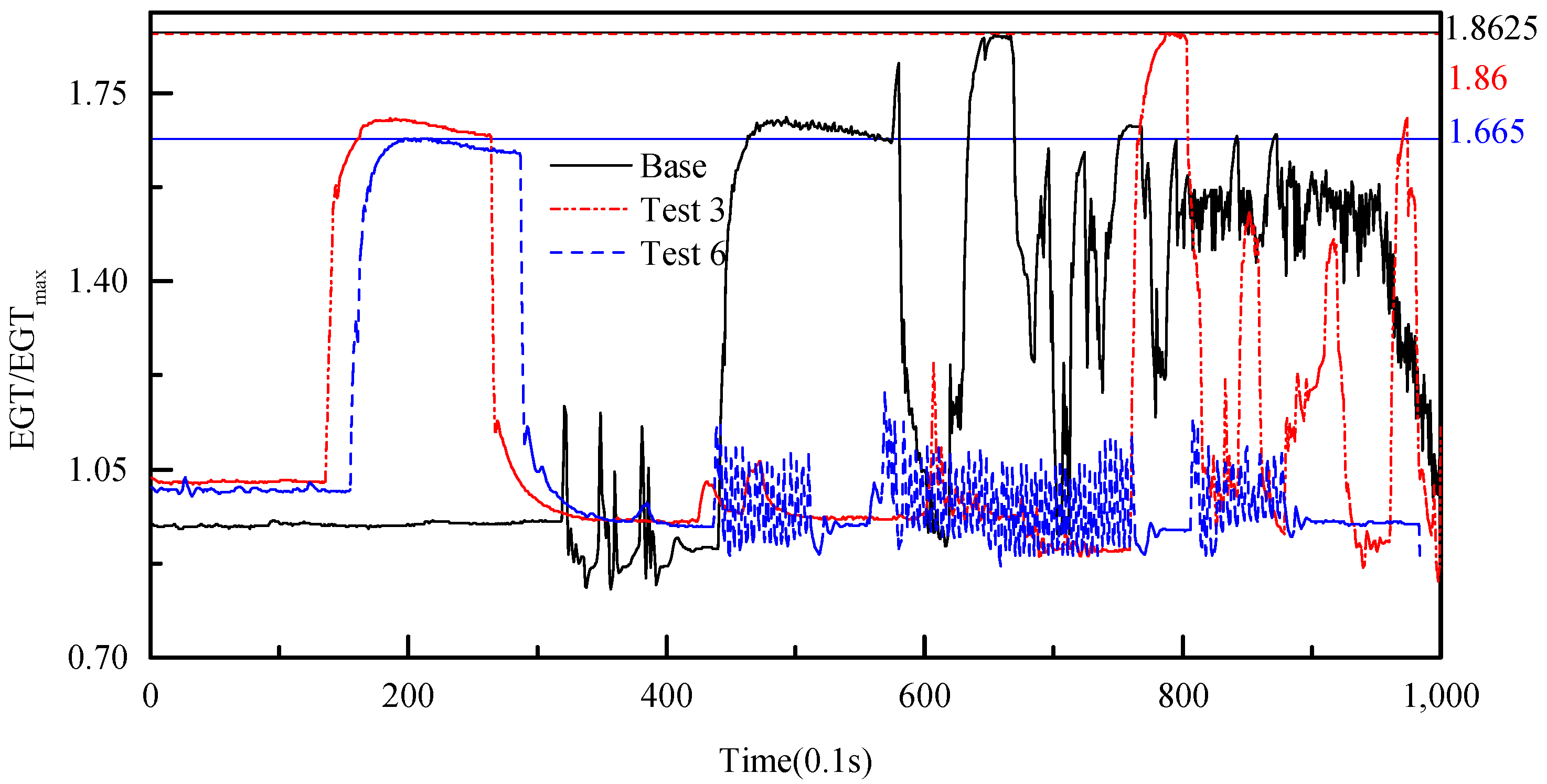
| Component Network | Input Features | Index |
|---|---|---|
| Inlet | Engine inlet temperature | 1 |
| Inlet total pressure | 2 | |
| Atmospheric humidity | 3 | |
| Fan | Rotational speed of the LP shaft | 4 |
| Angle of the LP guide vane | 5 | |
| Total pressure at the fan outlet | 6 | |
| Compressor | Rotational speed of the HP shaft | 7 |
| Angle of the HP guide vane | 8 | |
| Combustor | Pressure at the combustor inlet | 9 |
| Temperature at the combustor inlet | 10 | |
| HPT | Rotational speed of the HP shaft | 7 |
| LPT | Rotational speed of the LP shaft | 4 |
| Temperature at the turbine outlet | 11 | |
| Nozzle | Throat diameter | 12 |
| Lubricating | Oil pressure of the PL | 13 |
| Control system | Engine throttle control level | 14 |
| Fuel flow | 15 |
| Parameter | Value |
|---|---|
| Batch size | 20 |
| Optimizer | Adam/Rmsprop |
| Epoch | 300 |
| Weight initialization | Glorot uniform |
| Bias initialization | Zeros |
| Sequence length | 10 |
| Test Name | ARE (%) | MRE (%) | |||
|---|---|---|---|---|---|
| min | max | ave | std. | ave | |
| DM_1 | 0.2604 | 0.5093 | 0.3657 | 0.1097 | 7.6360 |
| DM_2-1 | 0.2795 | 0.8384 | 0.4947 | 0.2150 | 8.1922 |
| DM_2-2 | 1.3666 | 2.1833 | 1.7338 | 0.3521 | 13.4463 |
| DM_2-3 | 1.2545 | 2.2037 | 1.3818 | 0.3785 | 11.9756 |
| Test Name | ARE (%) | MRE (%) | |||
|---|---|---|---|---|---|
| min | max | ave | std. | ave | |
| Flight_1 | 0.9133 | 1.3212 | 1.0795 | 0.1727 | 12.6294 |
| Flight_2 | 0.2255 | 0.3367 | 0.2702 | 0.0456 | 10.2239 |
| Flight_3 | 0.2013 | 0.2930 | 0.2408 | 0.0367 | 4.7236 |
| Testing | Time (h) | Me (K) | ∆o (K) | ∆T (K) | ∆D (K) |
|---|---|---|---|---|---|
| Base | 0.00 | 4.700 | 4.700 | 0 | 0.000 |
| Test 1 | 3.89 | 8.298 | 2.112 | 0 | 1.485 |
| Test 2 | 4.44 | 9.213 | 2.745 | 1 | 1.768 |
| Test 3 | 5.36 | 8.381 | 1.886 | 1 | 1.795 |
| Test 4 | 6.00 | 9.763 | 3.904 | 1 | 1.158 |
| Test 5 | 6.66 | 11.908 | 3.029 | −1 | 4.179 |
| Test 6 | 6.73 | 11.462 | 0.651 | 79 | 6.111 |
Disclaimer/Publisher’s Note: The statements, opinions and data contained in all publications are solely those of the individual author(s) and contributor(s) and not of MDPI and/or the editor(s). MDPI and/or the editor(s) disclaim responsibility for any injury to people or property resulting from any ideas, methods, instructions or products referred to in the content. |
© 2024 by the authors. Licensee MDPI, Basel, Switzerland. This article is an open access article distributed under the terms and conditions of the Creative Commons Attribution (CC BY) license (https://creativecommons.org/licenses/by/4.0/).
Share and Cite
Lin, Z.; Xiao, D.; Xiao, H. Physics-Embedded Deep Learning to Predict Real-Time Flow Parameters in Complex Thermodynamic Machinery. Aerospace 2024, 11, 140. https://doi.org/10.3390/aerospace11020140
Lin Z, Xiao D, Xiao H. Physics-Embedded Deep Learning to Predict Real-Time Flow Parameters in Complex Thermodynamic Machinery. Aerospace. 2024; 11(2):140. https://doi.org/10.3390/aerospace11020140
Chicago/Turabian StyleLin, Zhifu, Dasheng Xiao, and Hong Xiao. 2024. "Physics-Embedded Deep Learning to Predict Real-Time Flow Parameters in Complex Thermodynamic Machinery" Aerospace 11, no. 2: 140. https://doi.org/10.3390/aerospace11020140
APA StyleLin, Z., Xiao, D., & Xiao, H. (2024). Physics-Embedded Deep Learning to Predict Real-Time Flow Parameters in Complex Thermodynamic Machinery. Aerospace, 11(2), 140. https://doi.org/10.3390/aerospace11020140






